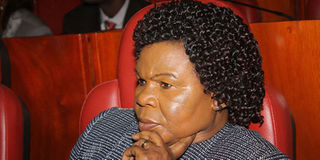Universities grapple with shortage of lecturers with PhDs

University Education Principal Secretary Collette Suda at a meeting with senators in 2015. She says lecturers must have PhDs. PHOTO | FILE | NATION MEDIA GROUP
What you need to know:
- Increase in enrolment in universities without corresponding increase in academic staff has led to a negative bias towards research performance.
- Both public and private universities had the highest number of academic staff at the rank of lecturer and the least at rank of professor.
Majority of lecturers in universities in the country are holders of a master’s degree, a report by higher education regulator indicates.
The Commission for University Education (CUE) says 53 per cent of academic staff have a masters qualification yet university lecturers have until October this year to possess doctorate degrees.
The development is likely to put pressure on the institutions as they comply with the CUE regulation that all assistant lecturers must acquire a PhD degree by October 2019 for them to qualify to teach in universities.
According to CUE, those who will not have attained the required academic qualifications by then should count themselves relieved of their duties.
The PhD requirement, according to an October 27, 2014 report on Harmonised Criteria and Guidelines for Appointment and Promotion of Academic Staff, will also affect private universities.
INCENTIVES
Recently, University Education Principal Secretary Collette Suda told the National Assembly’s Education committee that the government will do all it can to prevent a crisis in universities as they implement the directive. “We will ensure that this exercise is gradual,” Prof Suda said.
According to the CUE 2018 report covering 2016-2017, the increase in the number of lecturers with masters degrees is commensurate with the higher enrolment of students at bachelor’s degree who are mainly taught by master’s degree holders.
The report adds that the percentage of academic staff with PhDs qualification was 32 per cent.
“The representation of staff with higher levels of qualification at above 80 per cent is an indicator of quality human resource capacity for teaching and research. Universities should strive to develop capacity of the staff through incentives such as scholarships and reduced workloads.
"This would enable staff to progress in their studies and achieve doctorate qualification, especially those at lecturer rank without PhDs, so as to comply with the university standards and guidelines, 2014 and enhance expertise in their fields to become producers of knowledge through research,” the report reads.
RESEARCH
The report adds that among the proportion of all academic staff with PhDs, 71 per cent are male, and the scenario is replicated across all the other qualification levels with male representation being over 60 per cent at each level.
Between 2015 and 2016, academic staff with master's qualification, the report says increased by 14 per cent, while those with PhDs and bachelors increased by nine per cent and eight per cent, respectively.
“The share of academic staff at the rank of professor is the lowest at four per cent, while the share of academic staff at the rank of lecturer was highest at 35 per cent. The combined share of academic staff at senior ranks from senior lecturer to professor was at 21 per cent while the other ranks had a combined share of 79 per cent,” the report adds.
The report says the combination of teaching and research by academic staff is expected to be complementary, but increase in enrolment in universities without corresponding increase in academic staff has led to a negative bias towards research performance.
“Most academic staff have taken more teaching roles at the expense of research. Furthermore, the pressure of mass university education system in the country has also led to an increase in the number of universities without additional increase in staffing thereby leading to universities relying on part-time academic staff to support teaching especially in new universities,” the report observes.
STAFF SHORTAGE
It adds that without enough time and resources, universities cannot undertake the kind of research needed to transform the society.
The Universities Standards and Guidelines, 2014 require the ratio of full-time to part-time staff for the support of any academic programme to be 2:1.
“To achieve this, universities must develop programmes that expand their post-graduate training for purposes of capacity building. Expansion of universities to provide access to university education should be matched with staff development programmes to provide the critically needed staff in the future,” the report says.
University staff in universities are classified into six ranks: graduate assistant, assistant lecturer, lecturer, senior lecturer, associate professor and professor.
The data was collected from 30 public chartered universities, five public university constituent colleges, 18 private universities, four private university constituent colleges and 13 universities with letters of interim authority.
DIVERSITY
The report further states that the number of academic staff between the year 2016 and 2017 in both public and private universities increased by 14 per cent and 18 per cent, respectively.
The report also indicates that female lecturers represented 34 per cent of the total academic staff in universities.
In public universities, female lecturers represented 32 per cent of teaching staff while in private universities they represented 38 per cent.
It shows that large number of academic staff are in public universities at 13,258 compared to private universities that had 4,747.
It also shows that both public and private universities had the highest number of academic staff at the rank of lecturer and the least at rank of professor.
The highest proportion of academic staff were Business and Administration, Humanities and Arts, and health and welfare whose proportion of staff to the total academic staff was 16 per cent, 12 per cent and 11 per cent, respectively.
The reason, the report says, is mainly due to increase in the number of universities and programmes without a corresponding increase in staffing.




